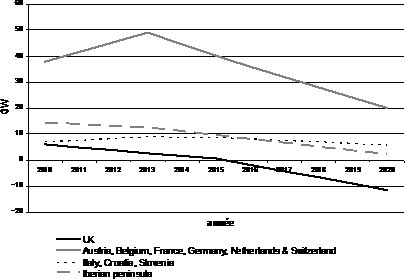Although overcapacity in Europe plus excessive renewable installations remain the biggest threat to power prices, and a quick price recovery seems highly unlikely, these are the main reasons why i believe we could be reaching a bottom:
- . I believe CO2 has reached a very strong support level at €13/MT. Utilities keep adding to their hedges at this level despite demand concerns. Even with -1% demand in 2010-2011 a CO2 price of €12-13/MT is widely accepted as a solid risk-reward price (basically the NPV of 2013 €23/MT with a 10% discount).
- . I believe demand is showing some small but encouraging signals of bottoming. We have seen encouraging data from the countries with highest overcapacity like Spain and Italy. Demand data for Spain for June is down only 2.7%, versus down 8% in May. This is temperature and working days adjusted, so not influenced by external factors. Same trend was seen in Italy with June figures only down 3% adjusted.
- . Capex cuts could reach 15% in 2010. Moody’s and S&P are demanding (expecting) power capex cuts in 2010 to reach up to 15% in Europe’s rated power groups. I had a chat with Neil Bissett from Moody’s yesterday in which they believed that generation companies should start thinking about moving closer to more cyclical company-type of gearing. That is c30% net debt/nd+equity!. Not only large groups are facing higher pressure to control capex and gearing, but smaller power companies are likely to be unable to finance agressive growth plans in current conditions. The effect is likely to be evident in 2011 and will hopefully bring reserve margins to tighter levels in Europe.
- . Gas prices look well supported into summer by ongoing Norwegian supply discipline (and more worryingly, inability to offset decline) and revamped Russia-Ukraine dispute risk. However, winter looks uncertain. The gas market is the key uncertainty to this picture as it looks awful considering LNG.
- . …But maybe the threat of LNG could be less agressive. You know me, I always trust Exxon, and so far it works. BP, Exxon and BG are seeing enough Asia demand to close large long term contracts. Additionally BP believes through TNK that Russian gas production could be peaking as reserves could be overstated. Exxon wants LNG in the US for two reasons: a) lower US gas prices benefit them and b) lowers the valuation of gas assets which they would takeover gladly.
- . In coal we are seeing supportive data from recent broker comments of a tender for met coal out of Australia completed recently at US$132/t, which is the first deal above the benchmark price of US$129/t. Spot prices have rebounded from US$115–118/t last month, due to months of strong purchasing activity by the Chinese. Strong Chinese steel production, signs of an end to steel destocking in the world ex-China, as well as infrastructure constraints in Australia (Dalrymple Bay vessel queues up from 25 to 40 ships), have contributed to the move upwards.

